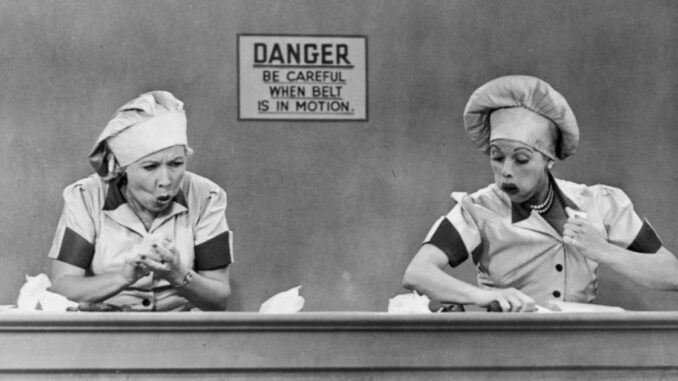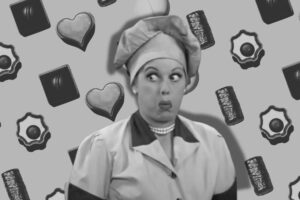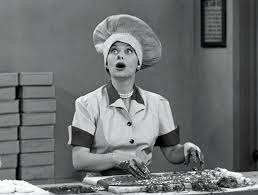
Introduction: Why This Episode Still Melts Hearts
Is there any scene more synonymous with comedy gold than Lucy and Ethel’s chaotic attempt to keep up with a conveyor belt of chocolates? The I Love Lucy chocolate factory episode, officially titled “Job Switching,” is one of the most beloved moments in television history. But what’s the real story behind this classic sitcom masterpiece? From behind-the-scenes challenges to the actors’ hilarious improvisations, let’s unwrap the truth behind this iconic piece of TV magic.
H1: A Quick Recap of the Chocolate Factory Episode
For those who need a refresher, “Job Switching” aired on September 15, 1952, and is the first episode of I Love Lucy’s second season. The storyline flips traditional gender roles as Lucy and Ethel head to work at a candy factory while Ricky and Fred try their hands at domestic chores. The chaos at the factory peaks during the conveyor belt scene, where Lucy and Ethel struggle to wrap chocolates as the belt speeds up, ultimately stuffing them into their hats, mouths, and blouses to avoid detection.

H2: The Inspiration Behind the Episode
What sparked the idea for this unforgettable storyline? The premise was rooted in the show’s goal of exploring relatable marital dynamics. By reversing the roles of breadwinner and homemaker, the episode poked fun at societal norms of the 1950s. But the conveyor belt gag? That came from the writers’ desire to place Lucy in a setting where physical comedy could shine.
H3: How Lucille Ball Prepared for the Role
Lucille Ball wasn’t just funny—she was a perfectionist. To ensure authenticity, Ball and co-star Vivian Vance trained with actual candy makers before filming. They visited a local candy factory to learn how to properly wrap chocolates, which only made the scene funnier when everything went off the rails.
H4: Behind-the-Scenes Challenges
Filming the conveyor belt scene wasn’t as smooth as it looked. The production team had to design a custom belt that could vary its speed to match the comedic timing. The chocolates themselves? They were real and often messy, leading to more than a few sticky situations on set. Lucille Ball reportedly gagged on the sweets during multiple takes, adding an element of authenticity to her over-the-top reactions.

H2: The Genius of Physical Comedy
The chocolate factory episode is a masterclass in physical comedy. Ball and Vance’s exaggerated movements, facial expressions, and sheer panic captured the absurdity of the moment. It wasn’t just about eating chocolates—it was about creating a visual symphony of chaos that audiences couldn’t look away from.
H3: Why the Scene Resonates With Audiences
So, why does this episode still strike a chord with fans decades later? It’s relatable! Who hasn’t felt overwhelmed by a task spiraling out of control? The conveyor belt symbolizes life’s moments when things move too fast, and you’re just trying to keep up—a universal experience wrapped in a layer of comedy.
H2: Fun Facts About the Chocolate Factory Episode
H3: The Candy Wrapper Cameos
The women who played the candy factory supervisors were real-life candy makers! This added a layer of authenticity to the scene, as their stern expressions were grounded in real factory experience.
H3: Lucille Ball’s Fear of Slapstick
Though she became a queen of physical comedy, Ball initially hesitated to perform such gags. She feared looking foolish on screen. Thankfully, she trusted her instincts—and the audience loved her for it.
H3: The Episode’s Legacy
“Job Switching” didn’t just entertain—it cemented I Love Lucy as a trailblazer in TV comedy. The scene has been parodied countless times, from Saturday Night Live to The Simpsons.
H2: Cultural Impact of the Episode
The chocolate factory scene transcended television, influencing everything from comedy writing to women’s roles on screen. It showed that female characters could be funny, flawed, and fiercely relatable, paving the way for generations of sitcom stars.
H3: Modern References and Parodies
Even decades later, the chocolate factory scene pops up in pop culture. Shows like Friends and The Big Bang Theory have paid homage to Lucy’s antics, proving its timeless appeal.
H2: How Lucille Ball Changed Comedy Forever
Lucy’s genius wasn’t just in her comedic timing—it was in her willingness to take risks. The chocolate factory episode epitomizes her bold approach, blending physical humor with heartfelt storytelling.
H3: Lessons We Can Learn From the Episode
- Embrace the Chaos: Life gets messy—lean into it like Lucy.
- Find Humor in Failure: Even when things go wrong, laughter can save the day.
- Teamwork Matters: Lucy and Ethel’s camaraderie highlights the power of friendship.
H2: Revisiting the Episode Today
Rewatching “Job Switching” feels like reconnecting with an old friend. The humor still lands, the performances still shine, and the message still resonates.
Conclusion: Why This Episode Will Always Be Sweet
The chocolate factory episode isn’t just a funny moment in TV history—it’s a cultural touchstone. Its blend of physical comedy, relatable chaos, and timeless charm ensures it will remain iconic for generations to come. Lucille Ball’s comedic brilliance shines as brightly today as it did in 1952, proving that sometimes, life really is just a box of chocolates.
FAQs
1. What candy was used in the chocolate factory scene?
The chocolates were real, sourced from a local candy maker, which added authenticity (and mess!) to the scene.
2. Was the conveyor belt real?
Yes, the production team created a functional conveyor belt that could be controlled to match comedic timing.
3. Did Lucille Ball do her own stunts?
Absolutely! Lucille Ball was a hands-on performer, embracing every messy moment for the sake of comedy.
4. Why is this episode so popular?
Its universal relatability and laugh-out-loud physical humor make it timelessly appealing.
5. Has the scene been parodied?
Countless times! It remains a favorite reference point in TV and film, cementing its place in pop culture.
